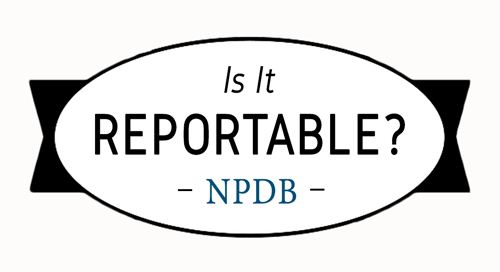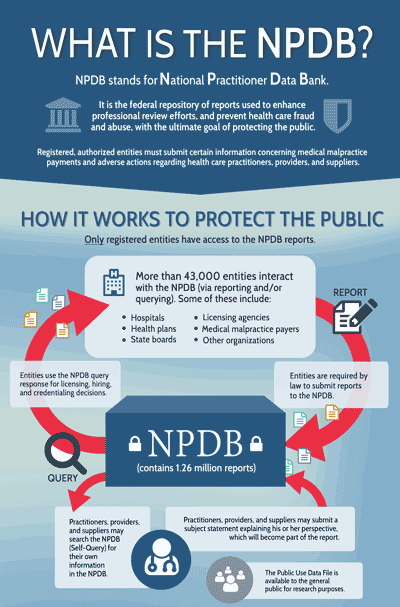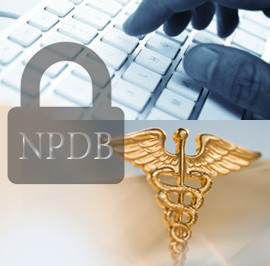Is It Reportable?
 A practitioner is meeting with the state’s licensing or certification authority to discuss options for entering into an impaired practitioner program. The practitioner receives a recommendation to enter into the program. Should the licensing or certification authority report the practitioner's entering into the program to the NPDB?
A practitioner is meeting with the state’s licensing or certification authority to discuss options for entering into an impaired practitioner program. The practitioner receives a recommendation to enter into the program. Should the licensing or certification authority report the practitioner's entering into the program to the NPDB?
If a practitioner voluntarily enters a treatment or rehabilitation program at the direction or suggestion of a licensing or certification authority and no action is taken, nor is there a surrender of the license or agreement not to practice, a report should not be submitted to the NPDB. If a licensure or certification action is taken (such as a probation, suspension, etc.) or the practitioner surrenders or agrees to refrain from practicing and the practitioner enters a treatment or rehabilitation program as a requirement of the action, the licensing or certification authority must report the action to the NPDB. The fact that the practitioner entered a drug or alcohol treatment program however should remain confidential.
NPDB Introduces Infographic Series
 As part of its efforts to educate users and the general public, the NPDB is developing a series of infographics that visually summarize NPDB concepts. The first two infographics are now available on the NPDB's website: "3 Reasons to Activate Continuous Query" and "What is the NPDB?"
As part of its efforts to educate users and the general public, the NPDB is developing a series of infographics that visually summarize NPDB concepts. The first two infographics are now available on the NPDB's website: "3 Reasons to Activate Continuous Query" and "What is the NPDB?"
"3 Reasons to Activate Continuous Query" educates users about the primary benefits of Continuous Query, and prints in an ink-saving format for easy sharing.
"What is the NPDB?" gives a visual overview of how reports come into the NPDB, who uses the reports, and breakdowns of the types of reports in the NPDB. It also gives general statistics about the content and volume of NPDB data. The infographic is available in a wide/landscape version, as well as an ink-saving, printer-friendly version.
The infographics can all be found on the Infographics page in the Help Center. NPDB Insights will continue to update you as more are released.
Keeping NPDB Information Confidential
 The NPDB sometimes receives questions about how an NPDB query response and any accompanying reports may be used. Information reported to the NPDB is considered confidential, and may not be disclosed except as specified in NPDB regulations. The Privacy Act of 1974 "prohibits the disclosure of a record about an individual from a system of records absent the written consent of the individual, unless the disclosure is pursuant to one of twelve statutory exceptions." It also requires the NPDB to "establish appropriate administrative, technical, and physical safeguards to insure the security and confidentiality of records and to protect against any anticipated threats or hazards to their security or integrity which could result in substantial harm, embarrassment, inconvenience, or unfairness to any individual on whom information is maintained."
The NPDB sometimes receives questions about how an NPDB query response and any accompanying reports may be used. Information reported to the NPDB is considered confidential, and may not be disclosed except as specified in NPDB regulations. The Privacy Act of 1974 "prohibits the disclosure of a record about an individual from a system of records absent the written consent of the individual, unless the disclosure is pursuant to one of twelve statutory exceptions." It also requires the NPDB to "establish appropriate administrative, technical, and physical safeguards to insure the security and confidentiality of records and to protect against any anticipated threats or hazards to their security or integrity which could result in substantial harm, embarrassment, inconvenience, or unfairness to any individual on whom information is maintained."
Sharing query responses and any accompanying reports with individuals or organizations outside of the querying organization's review process is prohibited. Everyone involved in the review process is subject to the confidentiality provisions of the NPDB. The strong security rules and limited access exist to not only protect the privacy of the individuals whose information resides within the NPDB, but also to help ensure the integrity of the information reported to the NPDB.
Health care organizations use NPDB information to facilitate review of practitioners when they are making determinations for the purpose of credentialing, privileging, hiring, and licensing. For these reasons, the general public only has access to the NPDB’s Public Use File, which contains statistical information only and does not identify individual practitioners. However, many state health care licensing websites provide a practitioner search on their health care licensing websites that may be accessed by the general public.
The information the NPDB contains is sensitive in nature, and this security is a result of the balance between protecting the accuracy and privacy of the practitioner’s information, as well as fulfilling the mission of protecting the health care community and the public at large.



 CLOSE
CLOSE